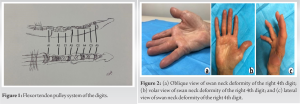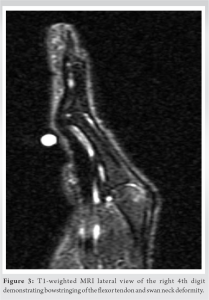Recognition of an uncommon deformity following a routine procedure.
Dr. Alexander K Hahn, Drexel University College of Medicine, MS, 2900 W Queen Ln, Philadelphia, Pennsylvania 19128, United States. E-mail: ah3389@drexel.edu
Introduction: Swan neck deformity (SND) is a common pathologic finding often observed in patients with severe rheumatoid arthritis. However, it has also been seen in injuries such as mallet finger, flexor digitorum superficialis laceration, and intrinsic contracture. Open surgical release of a trigger finger most commonly involves the release of the A1 pulley to relieve a mechanical impingement. Bowstringing is a rare trigger finger release complication caused by excessive pulley resection, usually due to resection of the A2 pulley. As a result of this complication, the flexor tendons move away from their center of rotation, gaining an increased mechanical advantage over the extensors and can ultimately result in a SND.
Case Report: We present a case report of a 61-year-old patient that presented to our clinic with a SND of the 4th digit following a trigger finger release.
Conclusion: Our case demonstrated that a previous trigger finger release with disruption of the A2 pulley can cause a cascade of events that can result in SND.
Keywords: Swan neck, trigger finger, deformity, bowstringing.
Open surgical release of a trigger finger typically involves the release of the A1 pulley to relieve a mechanical impingement, most commonly at the 2nd and 4th digit [1]. Complications of trigger finger release can include incision into the A2 or A4 pulley (Fig. 1), which can result in bowstringing of the flexor tendon [2, 3]. Other common complications include wound dehiscence, scar tenderness, and stiffness. To date, there have been no reported cases in the literature documenting SND as a complication after trigger finger release. We present a case report of a patient that presented to our clinic with a SND of the 4th digit after trigger finger release at an outside facility. SND is a common pathologic finding often seen with severe rheumatoid arthritis. However, it has also been seen in injuries such as mallet finger, flexor digitorum superficialis laceration, and intrinsic contracture [4]. SND is characterized by proximal interphalangeal (PIP) joint hyperextension, along with flexion of the distal interphalangeal (DIP) joint [4]. A primary lesion of SND is a laxed volar plate which caused hyperextension at the PIP. Secondary lesions of SND are caused by an imbalance of muscle forces and hyperextension of the PIP joint [4, 5]. Three sets of muscles and tendons provide the normal anatomic equilibrium and prevent SND occurrence. These include the extrinsic extensor group, the extrinsic flexor group, and intrinsic muscles. SND is thought to result from the extensors’ force overcoming the flexor tendons’ force, which impairs the balance between these two muscle groups. As a result, it can lead to restrictions in range of motion and can restrict a patient from making a fist [4, 5, 6]. The previous literature has described a lack of full extension at the MCP due to bowstringing after trigger finger release [7]. Bowstringing is a rare trigger finger release complication caused by excessive proximal pulley resection, usually due to resection of the A2 pulley. As a result, the flexor tendon moves away from its center of rotation, gaining an increased mechanical advantage over the extensors, thereby limiting extension [7]. This causes the finger to be slightly flexed due to the untethered tendons. As presented in our case, we suspect that this SND occurred due to initial bowstringing from a resected A2 pulley during our patient’s trigger finger release. This mechanical shift changed the force applied to the finger joints by the tendons and ultimately resulted in a SND.
We present a case of SND of the right fourth finger in a 61-year-old female who had undergone an A1 pulley release at an outside facility and presented for evaluation of a right 4th digit swan-neck deformity (Fig. 2a-c). 

Our case report demonstrates a 61-year-old female who presented with a passively correctable swan-neck deformity of the right ring finger in the setting of the previous A1 pulley release of the digit. MRI demonstrated disruption of the A2 pulley, bowstringing of the flexor tendons at the metacarpal and proximal phalanx level resulting in MCP flexion and a SND. In addition, a physical examination revealed that passive pressure at the level of the A2 pulley corrected the deformity. Considering these findings, the patient was trialed on an A2 pulley ring splint, continued motion, and therapy to work on flexion. The patient followed up in 4 weeks with improvement in her deformity. In addition, she was not tolerating the ring splint; therefore, a new one was fabricated, and she will follow up in another 4–6 weeks.
Trigger finger release surgery is a common procedure performed in hand surgery. It is a release of the A1 pulley, which is a fibrous band at the level of the MCP [2]. These pulleys tether the flexor tendons to the phalanx bones to provide structural support. In addition, the pulleys allow for proper balance between the flexor and extensor tendons on each finger joint [8]. Trigger finger in the adult patient is a common cause of hand pain and can result in a permanent flexion of the digit due to a disruption in the usual smooth gliding of the flexor tendon past these pulleys. Trigger finger is caused by fibrocartilaginous metaplasia at the level of the A1 pulley, which impedes the movement of the flexor tendons passing through the pulley [1]. Therefore, when performing a trigger finger release, care must be taken not to extend into the A2 pulley to prevent bowstringing [2, 3, 7]. Bowstringing presents as limited extension of the affected digit, in addition to passive flexion of the digit, due to increased mechanical advantage of the flexor tendons. In addition, to cosmetic and functional concerns of the digit, bowstringing may also present with pain [9]. Swan neck deformity (SND) is more commonly seen in patients with debilitating joint diseases such as rheumatoid arthritis. The main mechanism behind SND is hyperextension of the proximal interphalangeal (PIP) joint, which can occur due to various intrinsic or extrinsic factors. In primary SND, hyperextension can be caused by trauma, inflammation, or other factors that lead to volar plate laxity. The volar plate is a fibrocartilaginous structure that normally provides stability to the PIP joint In secondary SND, imbalanced forces between the flexors and extensors at the PIP joint result in hyperextension of the joint. This imbalance can be due to various causes such as mallet injuries, FDS tendon rupture, intrinsic contracture, or MCP joint volar subluxation [6]. In normal swan neck occurrences, the addition of flexion at the MCP is variable, with most presenting with no MCP flexion. Our case is the first known to describe an incidence of SND following a 4th digit trigger finger release at the A1 pulley. A proposed mechanism of how this occurred is a possible transection of the A2 pulley during our patient’s previous A1 pulley release at an outside hospital. This resulted in bowstringing of the finger, for which she received a splint. She then presented to our clinic with a SND, for which we ordered an MRI. The MRI showed bowstringing at the A2 pulley of the right ring finger. The prolonged bowstringing she experienced caused a flexion contracture at the MCP. This flexion contracture then caused a compensatory hyperextension at the PIP. The combined flexion at the MCP and hyperextension at the PIP caused a flexion at the DIP and resulted in the SND [10]. The cascade of events that occurred in our patient has not been described in the literature that an A2 pulley release during trigger finger surgery can cause a SND. However, the order of events described earlier in this report demonstrates how the mechanics can result in SND. Identifying the underlying cause of SND is crucial for determining the appropriate treatment plan. Therefore, when patients present with SND it is essential to do history and physical and include the previous trigger finger releases in the differential for possible causes.
SND is mainly caused by debilitating arthritis such as rheumatoid arthritis, volar plate laxity, or a disruption of the equilibrium of the flexors and extensors that act at the level of the PIP. Our case demonstrated that a previous trigger finger release with disruption of the A2 pulley can cause a cascade of events that can result in SND. Therefore, completing a good history and physical exam and being cautious of patients developing a SND post-trigger finger is critical.
SND can be a complication following a trigger finger release. Due to the given the frequency of this procedure, this case report serves to increase the surveillance of such deformities in patients.
References
- 1.Makkouk AH, Oetgen ME, Swigart CR, Dodds SD. Trigger finger: Etiology, evaluation, and treatment. Curr Rev Musculoskelet Med 2008;1:92-6. [Google Scholar]
- 2.Finsen V, Hagen S. Surgery for trigger finger. Hand Surg 2003;8:201-3. [Google Scholar]
- 3.Turowski GA, Zdankiewicz PD, Thomson JG. The results of surgical treatment of trigger finger. J Hand Surg Am 1997;22:145-9. [Google Scholar]
- 4.Dreyfus JN, Schnitzer TJ. Pathogenesis and differential diagnosis of the swan-neck deformity. Semin Arthritis Rheum 1983;13:200-11. [Google Scholar]
- 5.Harrison SH. Swan’s neck deformity of the fingers. Br J Plast Surg 1965;18:79-87. [Google Scholar]
- 6.De Salamanca FE. Swan-neck deformity: Mechanism and surgical treatment. Hand 1976;8:215-21. [Google Scholar]
- 7.Heithoff SJ, Millender LH, Helman J. Bowstringing as a complication of trigger finger release. J Hand Surg Am 1988;13:567-70. [Google Scholar]
- 8.Alanazi G, Langschmidt J, Rust P. Investigation into the functional anatomy of the flexor tendon pulley system of the hand. Int J Surg 2017;47:S68. [Google Scholar]
- 9.Leeflang S, Coert JH. The role of proximal pulleys in preventing tendon bowstringing: Pulley rupture and tendon bowstringing. J Plast Reconstr Aesthet Surg 2014;67:822-7. [Google Scholar]
- 10.McKeon KE, Lee DH. Posttraumatic boutonnière and swan neck deformities. J Am Acad Orthop Surg 2015;23:623-32. [Google Scholar]









